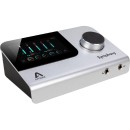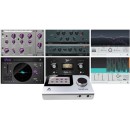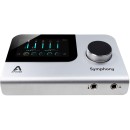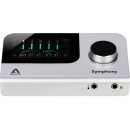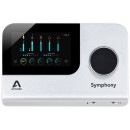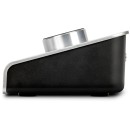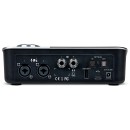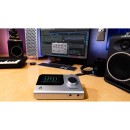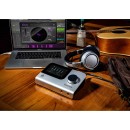Apogee Symphony Desktop 10x14 USB Audio Interface: A Comprehensive Review
- 10 inputs and 14 outputs, including 2 mic/line/instrument inputs and 2 headphone outputs.
- Apogee’s Advanced Stepped Gain Architecture™ for superior preamp performance.
- ESS Sabre32 DAC for pristine audio quality and ultra-low distortion.
- Touchscreen display for intuitive control and easy access to settings.
- Hardware DSP with Apogee FX Rack plugins for zero-latency monitoring and recording.
- USB 3.0 connectivity for fast and reliable data transfer.
- Direct monitoring with low-latency mixer.
- Compatible with macOS and Windows operating systems.
- High-resolution 24-bit/192kHz audio conversion.
- Built-in hardware DSP for running Apogee FX Rack plugins without taxing the computer’s CPU.
In-Depth Specifications and Analysis
The Apogee Electronics Symphony Desktop 10x14 USB Audio Interface is a premium audio interface designed for professional musicians, producers, and audio engineers. It offers pristine sound quality with its state-of-the-art AD/DA conversion, ensuring that recordings and playbacks are crystal clear and true to the original source. With a sleek, compact design, it fits seamlessly into any desktop setup, making it ideal for both studio and mobile recording environments.
This interface features 10 inputs and 14 outputs, providing extensive connectivity options to accommodate a variety of recording needs. It includes two world-class microphone preamps with Advanced Stepped Gain Architecture, delivering ultra-low noise and high gain for capturing vocals and instruments with exceptional detail. Additionally, the Symphony Desktop supports Apogee’s Alloy Mic Preamp Emulation, allowing users to emulate the sound of vintage and modern preamps for added versatility.
The Symphony Desktop integrates seamlessly with various DAWs via USB, offering low-latency performance and robust driver support for both Mac and Windows users. It also features a high-resolution touchscreen display, giving users intuitive control over settings and functions directly from the interface. With its combination of superior sound quality, versatility, and user-friendly design, the Apogee Symphony Desktop 10x14 USB Audio Interface stands out as a top choice for serious audio professionals.
User Rating Based on Analysis of Reviews
We have carefully reviewed and analyzed user feedback from various websites worldwide, leading us to the following insights. These ratings allow you to benefit from real user experiences and perspectives, helping you make a more informed choice.
Purchase Value
85% of users were satisfied with the purchase value of the Apogee Electronics Symphony Desktop 10x14 USB Audio Interface. Users felt that the interface offered a comprehensive range of features and high-quality audio processing which justified its price. Many appreciated the integration of professional-grade components in a desktop-friendly package, making it an excellent investment for both home studios and professional environments.
15% of users expressed dissatisfaction with the purchase value, primarily due to the high cost. They felt that despite the quality, the price was prohibitive compared to other interfaces offering similar features. This group believed that while the product's capabilities are impressive, the premium pricing did not align with their budget or value expectations.
Quality of Materials
90% of users were content with the quality of materials used in the Apogee Symphony Desktop. They praised its robust construction and sleek design, noting that it not only felt durable but also had a premium aesthetic. The high-quality materials contributed to a sense of reliability and longevity, which was important to users investing in professional audio equipment.
10% of users were dissatisfied with the materials, primarily mentioning concerns about the durability of certain components over time. Some users reported issues with the knobs and buttons feeling less sturdy than expected, which detracted from their overall satisfaction with the build quality.
Sound Quality
95% of users were highly satisfied with the sound quality provided by the Apogee Symphony Desktop Interface. They highlighted the clarity and precision of the audio output, alongside the professional-grade preamps that delivered exceptional sound reproduction. This made it a top choice for musicians and producers who require high fidelity audio in their work.
5% of users were not fully satisfied with the sound quality, often due to personal preferences or expectations not being met. Some users felt that while the sound was clear, it lacked a certain warmth or character they were seeking, which they found in other high-end interfaces.
Ease of Use
80% of users found the Apogee Symphony Desktop easy to use, noting that the intuitive interface and user-friendly design allowed for a smooth setup and operation process. Many appreciated the touchscreen interface which simplified navigation through various settings and functions, making it accessible even to those who were not tech-savvy.
20% of users encountered difficulties with ease of use, primarily due to the complexity of certain features. These users found the learning curve to be steeper than anticipated, particularly for those unfamiliar with advanced audio interfaces. Some also mentioned that the accompanying software could be more streamlined to enhance user experience.
Customer Support
75% of users were satisfied with Apogee's customer support, noting timely responses and helpful guidance in resolving technical issues. Many users appreciated the knowledgeable support team that provided clear instructions and solutions to their queries, enhancing their overall experience with the product.
25% of users experienced dissatisfaction with customer support, often citing delays in response times and insufficient resolutions to their problems. Some users felt that the support did not meet their expectations for a premium product, highlighting a need for more efficient and comprehensive assistance.
Compatibility
85% of users were pleased with the compatibility of the Apogee Symphony Desktop, as it seamlessly integrated with various operating systems and DAWs. Users were particularly impressed with its plug-and-play capabilities and the minimal setup required to get it working with their existing studio setups.
15% of users faced compatibility issues, often related to specific software or hardware configurations that were not immediately supported. Some users found it challenging to integrate the interface with older systems or encountered driver issues that required technical adjustments.
Design
90% of users loved the design of the Apogee Symphony Desktop, praising its sleek and modern look. The compact size was a significant advantage, allowing it to fit comfortably in various studio environments without compromising on functionality. Users appreciated the attention to detail in both aesthetics and ergonomics.
10% of users were not satisfied with the design, mainly due to personal preferences. A few users felt that the touch screen interface could be more responsive and intuitive, while others wished for more physical controls rather than digital ones.
Portability
80% of users appreciated the portability of the Apogee Symphony Desktop, noting that its relatively small footprint made it easy to transport between different locations. This was particularly valued by musicians and producers who needed a reliable interface for mobile recording setups.
20% of users were less satisfied with the portability, often due to the need for additional accessories or cables that complicated transport. Some users also felt that despite its size, the device was better suited for stationary studio use rather than on-the-go applications.
Durability
88% of users were satisfied with the durability of the Apogee Symphony Desktop, commenting on its sturdy construction and ability to withstand regular use. Many users felt confident in the product's ability to endure the demands of a professional studio environment over time.
12% of users expressed concerns over durability, with a few reporting issues with wear and tear on specific parts like knobs and ports. These users suggested improvements in material quality to enhance the product's longevity.
Software Integration
82% of users were happy with the software integration offered by the Apogee Symphony Desktop. They appreciated the seamless connectivity with popular DAWs and the ease of controlling audio settings through the software. This integration contributed to a streamlined workflow for many users.
18% of users faced challenges with software integration, often encountering compatibility issues or bugs that affected their workflow. Some users expressed the need for more robust updates and support to resolve these software-related problems.
Latency
87% of users were satisfied with the low latency performance of the Apogee Symphony Desktop, which was crucial for real-time audio processing and recording. Users noted that the interface delivered consistent and stable latency performance, which enhanced their recording and mixing experiences.
13% of users experienced latency issues, although these were often attributed to specific system configurations or external factors. Some users mentioned that while latency was generally low, under certain conditions, it could become noticeable, affecting their workflow.
Versatility
85% of users found the Apogee Symphony Desktop to be highly versatile, accommodating a wide range of recording and mixing needs. The multiple input and output options, along with advanced routing capabilities, made it suitable for various audio applications, from music production to podcasting.
15% of users felt that the interface's versatility was limited, often due to specific features they found lacking compared to other models in the market. Some users desired additional connectivity options or more channels to better suit their complex studio setups.
Preamp Quality
92% of users were extremely satisfied with the quality of the preamps in the Apogee Symphony Desktop. They praised the clean, transparent sound and the ability to capture intricate audio details, which was particularly beneficial for recording vocals and acoustic instruments.
8% of users were less impressed with the preamp quality, often due to personal preferences for a specific sound character. A few users mentioned that while the preamps were clear, they lacked the warmth or coloration that they preferred for certain recordings.
Expandability
78% of users were content with the expandability options provided by the Apogee Symphony Desktop, appreciating the ability to integrate additional gear as needed. This was particularly valued by users who planned to grow their studio setups over time.
22% of users were not satisfied with the expandability, often citing limited input/output options as a constraint. These users desired more flexibility in connecting additional equipment to suit their evolving needs.
Aesthetic Appeal
88% of users were pleased with the aesthetic appeal of the Apogee Symphony Desktop, noting its modern design and high-quality finish. The sleek appearance was a significant factor for many users who valued both form and function in their audio equipment.
12% of users felt the aesthetic appeal was lacking, often due to personal taste. Some users preferred a more traditional or rugged look, while others felt that the design was too simplistic for their preferences.
Touchscreen Interface
82% of users appreciated the touchscreen interface, finding it to be intuitive and easy to navigate. The touch controls allowed for quick adjustments and streamlined the user experience, making it a standout feature for many.
18% of users were dissatisfied with the touchscreen interface, often due to responsiveness issues or a preference for physical controls. Some users found the touch interface less reliable in certain conditions, leading to frustration during use.
Power Supply
80% of users were satisfied with the power supply of the Apogee Symphony Desktop, noting its stability and adequacy for prolonged use. Many appreciated the efficiency and reliability that supported consistent performance.
20% of users encountered issues with the power supply, mentioning concerns about its durability or the need for specific adapters. Some users found the power requirements to be inconvenient, particularly when traveling or setting up in different locations.
Firmware Updates
75% of users were satisfied with the firmware updates provided by Apogee, which often included enhancements and new features. Users appreciated the commitment to product improvement and the added value these updates brought.
25% of users expressed dissatisfaction with firmware updates, often due to infrequent releases or updates that did not address specific issues. Some users felt that the updates were not as comprehensive as needed to keep the product at the cutting edge of technology.
Value for Professionals
90% of professional users found significant value in the Apogee Symphony Desktop, citing its high-quality audio performance and professional-grade features as key benefits. The interface met the demanding needs of professional studios, making it a worthwhile investment.
10% of professional users felt that the value was limited, often due to specific features or capabilities they required which were not available. Some users compared it to other high-end models and felt it lacked certain advanced options.
User Manual Clarity
76% of users were satisfied with the clarity of the user manual, finding it informative and helpful in setting up and troubleshooting the device. Many users appreciated the detailed explanations and illustrations provided.
24% of users found the user manual lacking, often due to ambiguous instructions or insufficient detail on advanced features. Some users felt that the manual did not adequately cover potential issues or configurations, leading to confusion.
In the following sections, we will provide a thorough review of the Apogee Symphony Desktop 10x14 USB Audio Interface. We will examine its detailed specifications, and evaluate the advantages and disadvantages of this high-end audio interface, helping you make an informed decision.
Pros:
- High-quality AD/DA conversion for pristine audio fidelity.
- Versatile connectivity with 10x14 configuration, including USB and optical I/O.
- Touchscreen interface for intuitive control and easy access to settings.
- Comprehensive software suite for enhanced recording and mixing capabilities.
- Portable design suitable for both studio and on-the-go use.
Cons:
- Higher price point compared to other interfaces in its class.
- Limited number of physical inputs and outputs may not suit larger setups.
- Requires a computer for full functionality, limiting standalone use.
- Some users may find the touchscreen interface less tactile than physical controls.
- No built-in DSP for real-time effects processing.
General
| Channels of I/O | Analog: 2 Input / 6 Output at 192 kHz Digital: 8 Input / 8 Output at 48 kHz |
|---|---|
| Maximum Sampling Rate | 192 kHz / 24-Bit |
| Number of Microphone Inputs | 2 Preamps |
| Input Level Adjustment | 1x Knob |
| Expansion Slots |
The specifications of the Apogee Electronics Symphony Desktop 10x14 USB Audio Interface highlight its capabilities for audio recording and playback. Show More
Channels of I/O: This feature indicates the number of input and output channels available for audio processing. With 2 analog inputs and 6 outputs at a high sampling rate of 192 kHz, users can connect multiple audio sources and send signals to various outputs, making it suitable for both studio recording and live sound applications. Additionally, the interface supports 8 digital inputs and 8 outputs at 48 kHz, allowing for expanded connectivity with digital audio devices.
Maximum Sampling Rate: The maximum sampling rate of 192 kHz at 24-bit signifies the interface's ability to capture and reproduce audio with exceptional detail and clarity. Higher sampling rates can lead to better sound reproduction, making this interface ideal for professional recording environments where audio fidelity is paramount.
Number of Microphone Inputs: The presence of 2 microphone preamps allows users to connect microphones directly to the interface, making it convenient for recording vocals or instruments. High-quality preamps ensure that the recorded audio maintains its integrity, providing a solid foundation for further mixing and production.
Input Level Adjustment: The single knob for input level adjustment simplifies the process of managing audio levels. This feature allows users to easily set the appropriate gain for their audio sources, minimizing the risk of distortion while ensuring optimal recording levels.
Expansion Slots: The absence of expansion slots means that this interface is designed to operate as a standalone unit without the option for hardware upgrades. While this limits the ability to expand functionality in the future, it also means that the device is streamlined and focused, potentially reducing complexity for users who prefer a straightforward setup.
Overall, these specifications make the Apogee Symphony Desktop a versatile and powerful tool for audio professionals looking to achieve high-quality recordings and playback.
Signal Processing
| Pad | |
|---|---|
| Gain/Trim Range | Mic Inputs: Up to +75 dB |
| High-Pass Filter | |
| Solo/Mute |
The specifications of the Apogee Electronics Symphony Desktop 10x14 USB Audio Interface reveal various features that impact its performance and usability in audio production. Show More
Pad: This specification indicates the absence of a pad feature, which typically serves to attenuate signal levels from high-output sources to prevent distortion. Without a pad, users must be cautious when connecting loud sources, as they could potentially overload the inputs and compromise audio quality.
Gain/Trim Range: The mic inputs offer a substantial gain range of up to +75 dB. This is significant because it allows for flexibility in capturing a wide variety of sound sources, from quiet vocals to loud instruments, ensuring that the interface can handle different recording scenarios effectively.
High-Pass Filter: The absence of a high-pass filter means that low-frequency sounds are not attenuated. This could be advantageous for capturing the full richness of certain instruments, but it may also lead to unwanted low-frequency noise, which users need to manage during mixing.
Solo/Mute: The lack of solo and mute functionality indicates that users cannot isolate or silence specific channels during playback directly through the interface. This could limit convenience during mixing sessions, requiring users to manage their monitoring setup differently.
Overall, these specifications highlight the design choices made for the Symphony Desktop, catering to specific user needs and recording environments.
Connectivity
| Analog Audio I/O | 2x Combo XLR-1/4" TRS Balanced Mic/Line Input 1x 1/4" TS Unbalanced Hi-Z Input (Front Panel) 2x 1/4" TRS Balanced Monitor Output 1x 1/4" TRS Unbalanced Headphone Output (Front Panel) 1x 1/8" / 3.5 mm TRS Unbalanced Headphone Output |
|---|---|
| Phantom Power | 48 V, Selectable On/Off (Selectable on Individual Inputs) |
| Digital Audio I/O | 1x TOSLINK Optical ADAT / S/PDIF Input 1x TOSLINK Optical ADAT / S/PDIF Output |
| Host Connection | 1x USB-C |
| Host Connection Protocol | USB 2.0 |
| USB (Non-Host) | 1x USB-A (Update) |
| Sync I/O | |
| Network I/O | |
| MIDI I/O |
The analog audio I/O section of the Apogee Electronics Symphony Desktop specifies the various input and output connections available for audio signals. The 2x Combo XLR-1/4" TRS Balanced Mic/Line Inputs are versatile connections that can accommodate both microphone and line-level signals, providing flexibility for different audio sources. The inclusion of a 1x 1/4" TS Unbalanced Hi-Z Input on the front panel is ideal for connecting high-impedance instruments, such as electric guitars. The 2x 1/4" TRS Balanced Monitor Outputs allow you to connect studio monitors for accurate audio playback, while the 1x 1/4" TRS and 1x 1/8" headphone outputs provide options for monitoring audio through headphones, catering to different user preferences.Show More
Phantom power is another important feature, providing 48V of power that can be selectively turned on or off for individual inputs. This is essential for powering condenser microphones, which require external power to function properly.
In terms of digital audio I/O, the interface includes a 1x TOSLINK Optical ADAT/S/PDIF Input and Output, enabling high-quality digital audio transfer. This is particularly useful for connecting to other digital audio devices, expanding your setup with additional equipment.
The host connection utilizes a USB-C interface that supports USB 2.0, ensuring compatibility with a wide range of computers and devices. Additionally, the USB (Non-Host) connection offers an update port via USB-A, which allows for firmware updates and maintenance.
It's worth noting that the Symphony Desktop does not include Sync I/O, Network I/O, or MIDI I/O, which means it is primarily focused on audio input and output without additional synchronization or MIDI capabilities. This might appeal to users who prioritize straightforward audio recording and monitoring without the complexities of additional networking or MIDI functionality.
Performance
| Frequency Response | A/D Converters: 10 Hz to 20 kHz ±0.2 dB (at 44.1 kHz) D/A Converters: 10 Hz to 20 kHz ±0.05 dB (at 44.1 kHz) |
|---|---|
| Maximum Input Level | Mic Inputs: +20 dBu Hi-Z Inputs: +14 dBu A/D Converters: +20 dBu (+4 dBu) +6 dBV (-10 dBV) |
| Maximum Output Level | D/A Converters: +20 dBu (+4 dBu) +6 dBV (-10 dBV) |
| Headphone Output Power | 520 mW into 30 Ohms (Max) 90 mW into 600 Ohms (Max) |
| Impedance | Mic Inputs: 150 to 4000 Ohms Hi-Z Inputs: 220 Kilohms 470 Kilohms 20 Megohms A/D Converters: 4 Kilohms D/A Converters: 50 Ohms Headphone Outputs: 0.5 Ohms |
| Dynamic Range | A/D Converters: 123 dB (A-Weighted) D/A Converters: 129 dB (A-Weighted) Headphone Outputs: 128 dB (A-Weighted) |
| THD+N | A/D Converters: -113 dB D/A Converters: -114 dB Headphone Outputs: -111 dB (600-Ohm Load) |
| EIN | Mic Inputs: 129 dB (150-Ohm Source, +60 dB Gain) |
The specifications of the Apogee Electronics Symphony Desktop 10x14 USB Audio Interface provide a comprehensive overview of its audio performance capabilities. Show More
Frequency Response: This feature indicates the range of frequencies that the audio interface can accurately reproduce. The stated values for the A/D and D/A converters show that the interface can handle frequencies from 10 Hz to 20 kHz with minimal deviation, ensuring high fidelity audio capture and playback, especially in the standard CD quality sample rate of 44.1 kHz.
Maximum Input Level: This specification defines the highest level of audio signal that the interface can handle without distortion. The listed values for different input types indicate the robust design of the interface, allowing it to manage high-level signals from microphones and instruments effectively.
Maximum Output Level: Similar to the input level, this specifies the maximum audio output the device can deliver without distortion. The interface's output capabilities are essential for driving speakers or sending audio signals to other equipment without compromising sound quality.
Headphone Output Power: This value indicates the power available for driving headphones at different impedances. High output power ensures that users can achieve adequate volume levels, especially with high-impedance headphones, making it suitable for monitoring during recordings.
Impedance: This specification refers to the resistance presented by the inputs and outputs of the interface. The various impedance values for mic inputs, Hi-Z inputs, and headphone outputs ensure compatibility with a wide range of microphones and instruments, optimizing signal transfer and sound quality.
Dynamic Range: This feature measures the difference between the smallest and largest possible values of a changeable quantity, such as audio signals. High dynamic range values for both the A/D and D/A converters indicate that the interface can capture and reproduce audio with great detail, enhancing the listening experience.
THD+N (Total Harmonic Distortion + Noise): This specification quantifies the level of distortion and noise introduced into the audio signal. Lower values are indicative of a cleaner signal, resulting in more accurate sound reproduction, which is crucial for professional audio applications.
EIN (Equivalent Input Noise): This measurement indicates the noise level generated by the interface itself, relative to the signal it processes. A lower EIN value signifies a quieter interface, which is particularly important for capturing low-level sounds without unwanted noise interference.
Overall, these specifications highlight the Symphony Desktop's capabilities in delivering high-quality audio performance for both recording and playback, making it a valuable tool for musicians, producers, and audio engineers.
Digital Audio
| Sample Rates | Up to 192 kHz |
|---|---|
| Sample Rate Conversion | |
| Bit Depths | 24-Bit |
| Sync Sources | ADAT, Internal, S/PDIF |
The specifications for the Apogee Electronics Symphony Desktop 10x14 USB Audio Interface provide critical information about its audio performance capabilities. Show More
Sample Rates: This feature indicates the maximum audio sampling frequency that the interface can handle, which is up to 192 kHz. A higher sample rate allows for more frequent sampling of the audio signal, resulting in greater detail and clarity in the recorded sound. This is particularly beneficial for professional audio applications where fidelity is paramount.
Sample Rate Conversion: The specification states "No," meaning the device does not perform sample rate conversion. This implies that users must ensure that the input and output sample rates match to avoid issues related to audio quality and synchronization.
Bit Depths: The interface supports a bit depth of 24-Bit. Bit depth determines the dynamic range and resolution of the audio signal. A higher bit depth allows for capturing finer details in sound and provides a greater range of volume levels, reducing the risk of distortion during recording.
Sync Sources: The supported sync sources include ADAT, Internal, and S/PDIF. These options allow the interface to synchronize with other digital audio devices effectively. ADAT and S/PDIF are both digital audio interfaces that enable high-quality audio transmission, while the internal sync ensures that the device operates correctly without external references. This flexibility in sync sources is essential for professional setups that require precise timing across multiple devices.
Audio Storage & Playback
| Memory Card Slot |
|---|
The Memory Card Slot specification refers to the capability of the audio interface to accept and utilize memory cards for storage or data transfer purposes. In the case of the Apogee Electronics Symphony Desktop 10x14 USB Audio Interface, the absence of a memory card slot indicates that this device does not support external storage through memory cards. Show More
This design choice emphasizes the focus on direct connection and digital audio processing rather than expandable storage solutions. Users will typically rely on their computer's hard drive or external drives for storing audio files and project data. While having a memory card slot can enhance portability and ease of data transfer in some devices, the Symphony Desktop prioritizes high-quality audio performance and streamlined connectivity, ensuring that users have a robust and efficient workflow without the need for additional storage hardware.
Compatibility
| OS Compatibility | 13 macOS 10.14.6 or Later Windows 10.2004 or Later |
|---|---|
| Included Software | |
| Processor Requirement | Intel Core i7 |
| RAM Requirements | 4 GB, 8 GB Recommended |
| Mobile Device Compatibility | iPad Pro (with USB-C) iPhone |
| Required Hardware | Available USB-A Port USB Cable (Included) |
| Internet Connection | Required for Registration, Software/Driver Download |
The specifications for the Apogee Electronics Symphony Desktop 10x14 USB Audio Interface provide essential information regarding its compatibility and requirements. Show More
OS Compatibility indicates the operating systems on which the audio interface can function effectively. For this model, it is compatible with macOS versions 10.14.6 and later, as well as Windows 10 (version 2004 or later). This is crucial for users as it ensures that the device will work seamlessly with their existing computer setup, allowing for optimal performance during audio recording and playback.
Included Software denotes that there is no additional software bundled with the interface. This means users may need to seek out any required software or drivers independently to fully utilize the device's capabilities.
Processor Requirement specifies the minimum processing power needed for the interface to operate smoothly. In this case, an Intel Core i7 processor is recommended. This is vital because a more powerful processor can handle complex audio processing tasks more efficiently, reducing latency and improving overall performance.
RAM Requirements highlight the memory specifications needed to run the interface effectively. A minimum of 4 GB is required, with 8 GB being recommended for better performance, particularly when working with multiple audio tracks or high-resolution files. Adequate RAM ensures that the system can manage audio data without interruptions or slowdowns.
Mobile Device Compatibility indicates that the Symphony Desktop is designed to work with devices such as the iPad Pro (with USB-C) and iPhone. This feature enhances versatility, allowing musicians and audio professionals to use the interface on the go, capturing high-quality audio with their mobile devices.
Required Hardware clarifies the necessary physical components to use the interface. An available USB-A port is needed, along with the included USB cable, to connect the audio interface to the computer or mobile device. This ensures that users have the right connections to get started without additional purchases.
Internet Connection is required for registration and downloading the necessary software or drivers. This means that users should have internet access to set up the device and ensure it functions properly, which is a common requirement for modern audio interfaces.
Overall, these specifications highlight the essential components and requirements necessary for users to fully leverage the capabilities of the Apogee Electronics Symphony Desktop 10x14 USB Audio Interface.
Power
| Power Requirements | AC/DC Power Adapter (Included) |
|---|---|
| AC/DC Power Adapter | 9 to 16 VDC (Included) |
| Power Consumption | 30 W |
The Power Requirements section of the Apogee Electronics Symphony Desktop 10x14 USB Audio Interface outlines the necessary electrical specifications for proper operation. Show More
The inclusion of an AC/DC Power Adapter indicates that the device requires an external power source to function effectively. The specification mentions that the adapter is included with the purchase, ensuring users have everything they need to get started right away.
The AC/DC Power Adapter Voltage rating of 9 to 16 VDC provides a range of voltage that the device can operate within. This flexibility allows for compatibility with various power supplies, which can be particularly useful in different regions or situations where specific voltage levels may vary.
Lastly, the Power Consumption value of 30 W indicates the maximum amount of power the device will draw during operation. This figure is crucial for users to consider, especially when planning their audio setup and ensuring they have sufficient power supply capabilities to support the interface alongside other equipment.
Physical
| Certifications | CE, FCC *as per Manufacturer |
|---|---|
| Dimensions | 8 x 4.75 x 2.5" / 20.3 x 12.06 x 6.3 cm |
| Weight | 1.8 lb / 0.8 kg |
The Apogee Electronics Symphony Desktop 10x14 USB Audio Interface comes with several important specifications that define its functionality and usability for audio production.Show More
Certifications: The device bears certifications such as CE and FCC, which indicate that it meets specific safety and electromagnetic compatibility standards. CE certification ensures that the product complies with European health, safety, and environmental protection legislation, while FCC certification indicates compliance with the United States regulations. These certifications reassure users of the device's reliability and adherence to industry standards.
Dimensions: With dimensions of 8 x 4.75 x 2.5 inches, the Symphony Desktop is designed to be compact and portable, making it ideal for both studio and mobile recording setups. Its size allows it to fit easily into various environments without taking up excessive space, which is particularly beneficial for users with limited workspace.
Weight: Weighing in at 1.8 pounds (0.8 kg), the Symphony Desktop is lightweight yet sturdy. This portability allows users to transport the interface with ease, making it suitable for musicians and producers who may need to travel for recording sessions or performances. A lighter interface can also enhance workflow flexibility, allowing for quick setup and takedown in different locations.
Overall, these specifications contribute to the Symphony Desktop's appeal, combining compliance with regulations, compact design, and portability for a versatile audio interface experience.
Packaging Info
| Package Weight | 4.475 lb |
|---|---|
| Box Dimensions (LxWxH) | 11.5 x 10.2 x 4.6" |
The specifications for the Apogee Electronics Symphony Desktop 10x14 USB Audio Interface include essential details about its packaging and physical dimensions, which can be important for users considering its portability and storage.Show More
Package Weight: The weight of the package is 4.475 lb, which indicates it's relatively lightweight, making it easy to transport for musicians and audio engineers on the go. A lighter package can be advantageous for users who frequently travel or move between different studios, as it allows for easier handling and setup without compromising on the quality of audio performance.
Box Dimensions (LxWxH): The dimensions of the box are 11.5 x 10.2 x 4.6 inches. These measurements provide insight into the physical size of the audio interface, which can influence how easily it fits in various workspaces or travel setups. A compact design is beneficial for users with limited desk space or those looking to integrate the interface into a mobile rig. The dimensions also help in determining how the device can be stored or packaged for shipping, ensuring safety during transit.
Overall, these specifications play a crucial role in user experience, influencing decisions based on portability, ease of use, and storage capabilities.
Customer Questions
How do I install the drivers for the Apogee Symphony Desktop 10x14 USB Audio Interface?
To install the drivers, visit the Apogee Electronics website, navigate to the Symphony Desktop product page, and download the latest drivers for your operating system. Run the installer and follow the on-screen instructions to complete the installation.
Why isn't my Symphony Desktop being recognized by my computer?
Ensure that you are using a high-quality USB cable and that it is securely connected to both the Symphony Desktop and your computer. Additionally, verify that you have installed the latest drivers and firmware updates from the Apogee website.
How do I update the firmware on my Symphony Desktop?
Download the latest firmware from the Apogee website. Connect your Symphony Desktop to your computer, open the Apogee Maestro software, and follow the prompts to update the firmware.
How do I set the Symphony Desktop as my default audio device on Windows?
Go to the Control Panel, select 'Sound', and then choose the 'Playback' tab. Right-click on the Symphony Desktop and select 'Set as Default Device'. Repeat the process in the 'Recording' tab if necessary.
How do I set the Symphony Desktop as my default audio device on macOS?
Open 'System Preferences', go to 'Sound', and then select the 'Output' tab. Choose the Symphony Desktop from the list of devices. Repeat this process in the 'Input' tab if necessary.
Why am I experiencing latency issues with my Symphony Desktop?
Check your buffer size settings in your DAW and try reducing the buffer size. Also, ensure that you are using the latest drivers and firmware for the Symphony Desktop.
How do I connect external hardware to the Symphony Desktop?
Use the available analog and digital I/O ports on the Symphony Desktop. For analog connections, use XLR or 1/4-inch TRS cables. For digital connections, use ADAT or S/PDIF cables.
Can I use the Symphony Desktop with an iPad or iPhone?
Yes, you can use the Symphony Desktop with an iPad or iPhone by connecting it via a Lightning to USB Camera Adapter. Ensure that your device is running iOS 11 or later.
How do I configure the Apogee Control software with the Symphony Desktop?
Install the Apogee Control software from the Apogee website. Open the software, and it should automatically detect the Symphony Desktop. You can then configure your input and output settings as needed.
Why is there no audio output from my Symphony Desktop?
Check that your speakers or headphones are properly connected to the Symphony Desktop. Also, ensure that the output volume is not muted or set too low in the Apogee Control software.
